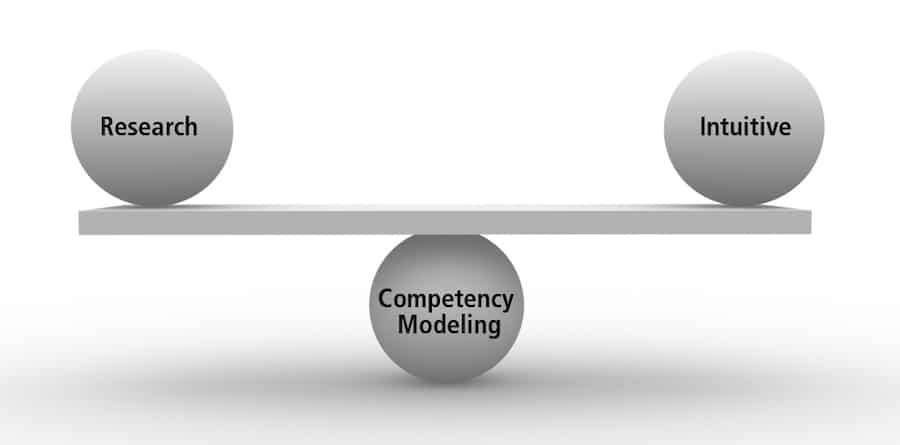There are three approaches to building a competency model:
1) Research
2) Intuitive
3) Balance of Research and Intuitive
1. Research Approach
Research approaches to competency model building emphasize systematic data collection and analysis, and a priori decision rules about how much evidence is sufficient to warrant inclusion of competencies and behaviors in the model. Research approaches also emphasize identifying coherent constructs of personal characteristics that are conceptually and empirically separate from each other. The earliest competency models built by Dr. David McClelland and his colleagues at McBer and Company used a research approach. Traditional job analysis, as practiced by industrial psychologists, also uses a research approach.

The principal advantage of a research approach is the validity of the resulting competency model. A research approach can accurately identify the behaviors currently demonstrated by superior performers and the beliefs by jobholders and other subject matter experts about what is currently important to superior performance. Because of its validity, a competency model developed using a research approach can withstand potential legal challenges.
A good description of a research approach is contained in “Competence At Work” a book that provides analysis of 650 jobs, based on 20 years of research using the McClelland/McBer job competence assessment (JCA) methodology. Included are generic job models for entrepreneurs, technical professionals, salespeople, service workers and corporate managers. It also defines JCA and describes in detail how to conduct JCA studies. Future directions and uses for competency research are also described.
2. Intuitive Approach
But research approaches are not as useful for identifying what will become important in the future, especially when only a few individuals in an organization have a clear strategic vision. Nor will a research approach generate a competency model that is linked to a leader’s vision of where he or she wants to take the organization.
Intuitive approaches rely heavily on the judgment and insights of the model building team. There may be little, if any, data collection and analysis, and the results of the analysis do not determine what is included in the competency model. Instead, the model building team generates ideas about what to include in the model and, after discussion, reaches consensus on the content of the model. Intuitive approaches are driven more by values than by empirical results.
The main advantage of intuitive approaches is that they can produce competency models that include all of the elements that the model building team and upper management believe are important in the model. Intuitive approaches are also less expensive, since they do not require collecting and analyzing data.
The chief disadvantage of intuitive approaches is that they risk creating competency models that describe behavior appropriate for a desired future state, rather than for the current reality. In addition, the lack of methodological rigor in constructing the models makes them vulnerable to legal challenges.
3. Balancing Research & Intuitive Approaches (Recommended)

Few competency models today are constructed with a pure research approach or with a pure intuitive approach. Most HR staffs want to collect and analyze data as part of the model building process. But they also want the freedom and flexibility to add competencies and behaviors to the model to ensure that it reflects the organization’s values and strategic direction, and to demonstrate responsiveness to the concerns of key stakeholders. Finding the right balance between research and intuitive approaches depends on the values of the internal HR team, the preferences of external consultants (if they are involved), and the extent to which the team feels a need to be responsive to the desires of upper management and other stakeholders in the model building process.
One method for balancing research and intuitive approaches is to use a research approach to develop a draft competency model and then to review the model with key stakeholders. If one or more of the key stakeholders urges a change in the model, the internal HR team may decide to make the change (e.g., by adding a competency to ensure that the model is more closely aligned with the chief executive’s values).
This method was used in building a competency model for managers of consultants in an information services consulting firm. When we reviewed the initial competency model with one of the senior executives of this firm, he suggested that we add a competency called “Managing Through Processes.” The firm had grown rapidly through acquisitions and by hiring staff from many other organizations, and it needed to integrate and control this diverse talent. The consulting staff was being taught to manage projects using a few standard methodologies. The addition of the proposed competency, which had not been evident in critical interviews with outstanding performers, supported the organization’s expansion strategy.
Another hybrid method involves using an intuitive approach to develop a prototype competency model and then collecting data and revising the prototype model based on analysis of the data. This methodology, developed by a colleague, Susan Ennis, was used in developing a leadership competency model for a large financial services company. The CEO of this company wanted to change the company’s culture to ensure continued competitiveness in a faster-moving marketplace. In the future, this organization would need to develop products and services more quickly, to form more business partnerships with other organizations, and to demonstrate more teamwork and open communication.
The external consultants, working with a team of internal HR staff, used an intuitive approach to develop a prototype model that reflected the values and behaviors that leaders would need in order to implement the desired cultural changes. The intuitive approach involved reading speeches to clarify the CEO’s values and strategic direction and helping the HR staff to articulate their own views of the current leaders’ strengths and weaknesses. We integrated this information with our knowledge of generic competencies for senior leaders to produce an initial draft version of the competency model. The behavioral indicators for this model were mostly drawn from a set of generic competencies that we had distilled from our experience creating many other leadership competency models. Then, over a one-week period, we held a series of telephone conference calls with an HR team to revise and refine the prototype model. Since the prototype model had to be shared with the CEO and other senior leaders, it was critical that the model be credible. In addition, the HR team believed that the model should have no more than ten competencies.
 After using a purely intuitive approach to develop the prototype model, we shifted to research to validate and refine the model, interviewing 12 outstanding senior managers. The HR staff selected a sample of high-performing senior managers who were also thought to demonstrate at least two of the competencies in the prototype model. Since one purpose of the interviews was to clarify the behaviors by which the prototype competencies were demonstrated, some of the interview questions were designed to elicit critical events involving demonstration of specific competencies that the interviewee was thought to possess. For example, if a senior manager was thought to possess the competency “Influence Skill,” she might be asked to describe a situation in which she needed to get another person or group to provide resources or support for an initiative.
After using a purely intuitive approach to develop the prototype model, we shifted to research to validate and refine the model, interviewing 12 outstanding senior managers. The HR staff selected a sample of high-performing senior managers who were also thought to demonstrate at least two of the competencies in the prototype model. Since one purpose of the interviews was to clarify the behaviors by which the prototype competencies were demonstrated, some of the interview questions were designed to elicit critical events involving demonstration of specific competencies that the interviewee was thought to possess. For example, if a senior manager was thought to possess the competency “Influence Skill,” she might be asked to describe a situation in which she needed to get another person or group to provide resources or support for an initiative.
Another purpose of the interviews was to reveal competencies and behaviors that were contributing to effectiveness but were not part of the prototype competency model. For this purpose we developed several questions to elicit more general critical events. For example, one prompt was, “Tell me about a time when you believe you demonstrated leadership within the work unit that you manage.”
We tape recorded and transcribed the 12 interviews. We analyzed them by coding each interview for each competency and behavioral indicator in the prototype competency model, and for a set of additional generic competencies not included in the prototype. The coding enabled us to tabulate the frequency of demonstration of all of these competencies.
The results of the coding analysis led us to recommend some changes in the prototype model, including the addition of one competency: “Motivating and Energizing People.” The HR team, after much discussion, decided to include the new competency, even though this meant having one more competency than the desired ten in the final model.
This topic is included in Key Questions to Answer before Building Competency Models Adapted From “Practical Questions for HR Professionals Who Are Building Competency Models—a Consultant’s Experience” By Dr. Richard S. Mansfield
 To learn more about our products and services, and how competencies and competency models can help your organization, call 800-870-9490, email edward.cripe@workitect.com
To learn more about our products and services, and how competencies and competency models can help your organization, call 800-870-9490, email edward.cripe@workitect.com
or use the contact form at Workitect.
©️2022, Workitect, Inc.



Leave A Comment